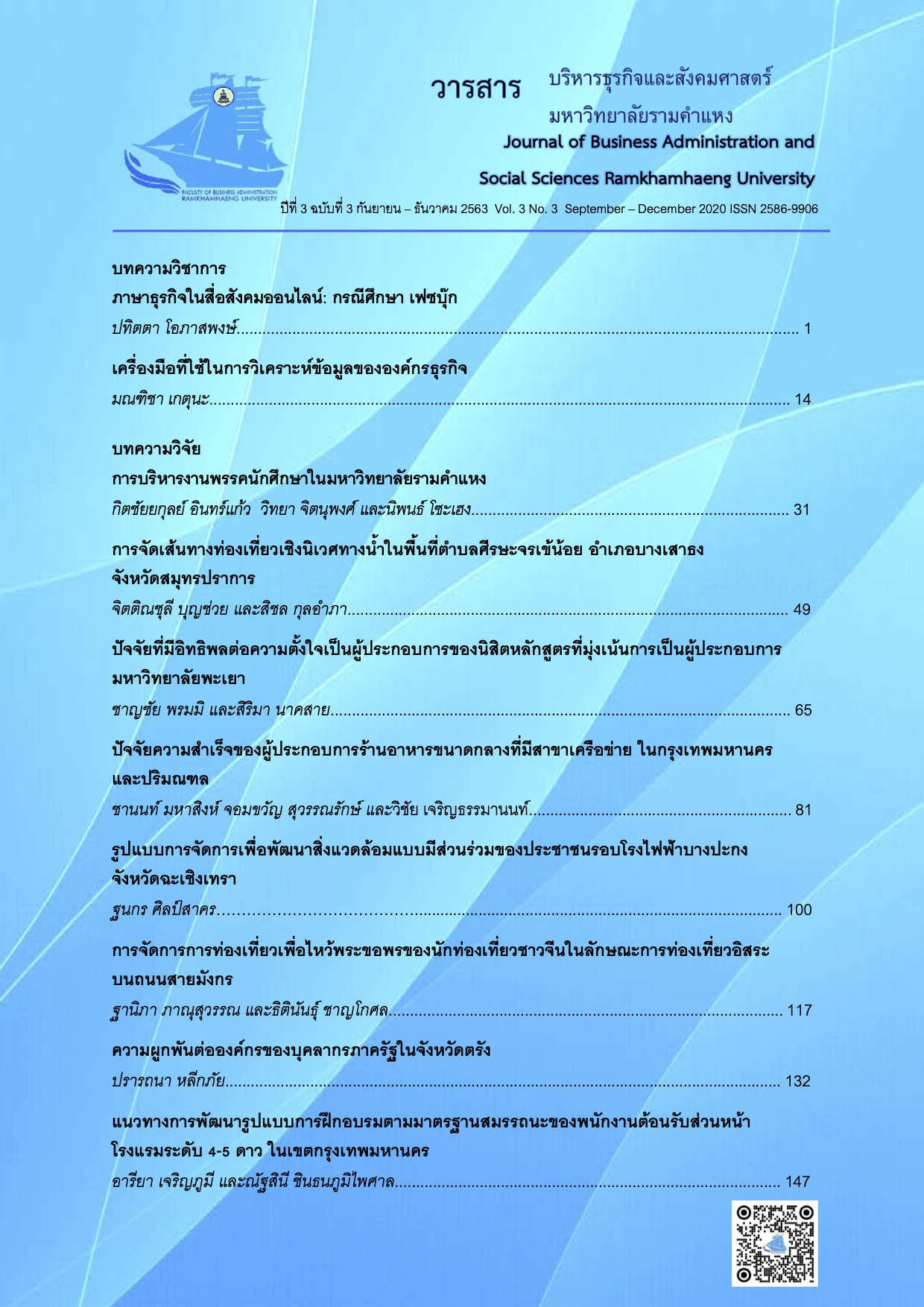The Management of Chinese Tourists' Tourism to Pay Respect to Buddha in the Style of Free Individual Tourism on Mangkon Road
Main Article Content
Abstract
In this research investigation, the researchers analyze (1) the exploratory factor analysis (EFA) of the tourism management model for Chinese tourists on Mangkon Road to pay respect to Buddha in the style of free individual tourism. The researchers present and confirm (2) the tourism management model for Chinese tourists on Mangkon Road to pay respect to Buddha in the style of free individual tourism.
In this mixed-methods research, a questionnaire was used as a research instrument to collect data from 400 Chinese tourists. In the qualitative research, interviews were conducted to evaluate and confirm the results of the EFA and the categorization model.
Findings showed the following. The factors of the tourism model for the management of Chinese tourists on Mangkon Road to pay respect to Buddha in the style of free individual tourism consisted of three components: 1) reliability; 2) readiness; and 3) efficiency. The analysis of the appropriateness and feasibility of the management model under study was evaluated and confirmed for appropriateness and actual implementation.
Article Details
เนื้อหาและข้อมูลในบทความที่ลงตีพิมพ์ในวารสารบริหารธุรกิจและสังคมศาสตร์ มหาวิทยาลัยรามคำแหง ถือเป็นข้อคิดเห็นและความรับผิดชอบของผู้เขียนบทความโดยตรง ซึ่งกองบรรณาธิการไม่จำเป็นต้องเห็นด้วย หรือร่วมรับผิดชอบใดๆ
บทความ ข้อมูล เนื้อหา รูปภาพ ฯลฯ ที่ได้รับการตีพิมพ์ในวารสารบริหารธุรกิจและสังคมศาสตร์ มหาวิทยาลัยรามคำแหง ถือเป็นลิขสิทธิ์ของวารสารบริหารธุรกิจและสังคมศาสตร์ มหาวิทยาลัยรามคำแหง หากบุคคลหรือหน่วยงานใดต้องการนำบทความทั้งหมดหรือส่วนหนึ่งส่วนใดไปเผยแพร่ต่อ หรือเพื่อกระทำการใดๆ จะต้องได้รับอนุญาตเป็นลายลักษณ์อักษรจากวารสารบริหารธุรกิจและสังคมศาสตร์ มหาวิทยาลัยรามคำแหง ก่อนเท่านั้น
References
กรวรรณ สังขกร อาชว์บารมี มณีตระกูลทอง และกาญจนา จี้รัตน์. (2559). ความคาดหวังและความพึงพอใจ
ของนักท่องเที่ยวจีนในประเทศไทย หลังกระแสภาพยนตร์ The Lost in Thailand (รายงานผลการวิจัย). เชียงใหม่: มหาวิทยาลัยเชียงใหม่
กัลยา วานิชย์บัญชา. (2556). การวิเคราะห์สมการโครงสร้าง (SEM) ด้วย AMOS. กรุงเทพฯ: ห้างหุ้นส่วน
จำกัดสามลดา.
ชนัญ วงษ์วิภาค. (2545). ประโยชน์ของการท่องเที่ยวเชิงวัฒนธรรม. เอกสารการสอนชุดวิชาประสบการณ์
วิชาชีพการจัดการการท่องเที่ยว.กรุงเทพฯ: มหาวิทยาลัยสุโขทัยธรรมาธิราช
ธานินทร์ ศิลป์จารุ. (2560). การวิจัยและวิเคราะห์ข้อมูลทางสถิติด้วย SPSS และ AMOS (พิมพ์ครั้งที่ 17).
กรุงเทพฯ: ห้างหุ้นส่วนสามัญบิสซิเนสอาร์แอนด์ดี.
บุญเลิศ จิตตั้งวัฒนา. (2548). การพัฒนาการท่องเที่ยวแบบยั่งยืน. กรุงเทพฯ: เพรส แอนด์ ดีไซน์.
ประเมศฐ์ พิชญ์พันธ์เดชา. (2561). การจัดการการท่องเที่ยวเชิงศาสนาของเกาะฮ่องกงที่มีอิทธิพลต่อ
นักท่องเที่ยวชาวไทย. วิทยานิพนธ์ศิลปศาสตรมหาบัณฑิต. มหาวิทยาลัยธรรมศาสตร์. กรุงเทพฯ.
พยอม ธรรมบุตร.(2549). เอกสารประกอบการเรียนการสอนเรื่องหลักการท่องเที่ยวเชิงอนุรักษ์. กรุงเทพฯ: สถาบันท่องเที่ยวเชิงอนุรักษ์ มหาวิทยาลัยศรีนครินทรวิโรฒ.
ไพรัตน์ สุระศิรานนท์. (2556). การศึกษาพฤติกรรมนักท่องเที่ยวชาวจีนแบบแบ็คแพ็คเกอร์ต่อการเลือกร้าน
อาหาร ในเขตกรุงเทพมหานคร. วิทยานิพนธ์อักษรศาสตรมหาบัณฑิต. จุฬาลงกรณ์มหาวิทยาลัย. กรุงเทพฯ.
วิกิพีเดีย. (2562). ถนนเยาวราช. สืบค้นเมื่อ 4 มีนาคม 2562, จาก https://th.wikipedia.org/wiki/ถนนเยาวราช
วีรศักดิ์ เกิดผลเจริญยิ่ง. (2556). นักท่องเที่ยวจีนยุคใหม่กับกระแสกำรท่องเที่ยวด้วยตนเอง. สืบค้นเมื่อ 4 มีนาคม, จาก
http://www.thaibizchina.com/thaibizchina/th/articles/detail.php?
ศศิธร เจตานนท์. (2558). แนวทางส่งเสริมการท่องเที่ยวสำหรับนักท่องเที่ยวชาวจีน ในเขต
กรุงเทพมหานคร. กรุงเทพฯ: มหาวิทยาลัยราชภัฏสวนสุนันทา.
ศุภลักษณ์ อัครางกูร. (2551). พฤติกรรมนักท่องเที่ยว. ขอนแก่น: คลังนานาวิทยา.
ศูนย์วิจัยกสิกร. (2561). แนวโน้มเศรษฐกิจและการท่องเที่ยวปี 2561. สืบค้นเมื่อ 9 พฤษภาคม
, จาก http://ttaa.or.th/wp-content/uploads/2017/09/เศรษฐกิจและการท่องเที่ยว.
Buhalis, D. (2000). Marketing the competitive destination of the future. Tourism
management, 21(1), 97-116.
Cochran, W. G. (1953). Sampling Techniques. New York: John Wiley & Sons. Inc.
College of Management Mahidol University. (2017). “หนีห่าว มาร์เก็ตติ้ง” เคล็ดลับมัดใจนักท่องเที่ยว
จีนสไตล์ FIT, สืบค้นเมื่อ 8 พฤษภาคม 2563, จาก
https://www.cm.mahidol.ac.th/cmmu/images/news/articles/2017-05-17-v1.pdf
Hair, J. F., Black, W. C., Babin, B. J., & Anderson, R. E. (2010). Multivariate Data Analysis. (7th ed.). Upper Saddle River, NJ: Prentice Hall.


